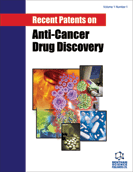
Abstract
Background: Polymers are used in drug delivery systems to encapsulate and release the drug. Natural polymers have the advantages of biodegradability, biocompatibility, and recognizable biological moieties that maintain cellular functions as compared to synthetic polymers. Chitosan is a natural polycationic linear polysaccharide that originates from chitin. Its easy modification, release rate of drug, ability to cross-link with other polymers, gelling ability, immunostimulation, bioadhesion, biocompatibility, and biodegradability has increased its application in various drug delivery systems.
Objective: The objective of the present study is to overview the recent patents of the application of chitosan in various drug delivery systems and their use in the prevention of cancer and other ailments.
Methods: In this review, the patent application of chitosan in various drug delivery systems employed to cure mainly cancer has been covered with particular emphasis on their scientific impact and novelty.
Results: Chitosan has proved its potential as a polymer to control and target the drug at the site of action.
Conclusion: The potential of chitosan and its derivatives to deliver and target the drug may open new avenues for therapeutic interventions in different tumors.
Keywords: Cancer, chitosan, modification, novel drug delivery system, patent, polymer.
Recent Patents on Anti-Cancer Drug Discovery
Title:Chitosan - A Potential Polymer to Prepare Anticancer Drug Delivery Systems: Patent Review
Volume: 16 Issue: 2
Author(s): Priyanka Kriplani*Kumar Guarve
Affiliation:
- Guru Gobind Singh College of Pharmacy, Yamuna Nagar 135001, Haryana,India
Keywords: Cancer, chitosan, modification, novel drug delivery system, patent, polymer.
Abstract:
Background: Polymers are used in drug delivery systems to encapsulate and release the drug. Natural polymers have the advantages of biodegradability, biocompatibility, and recognizable biological moieties that maintain cellular functions as compared to synthetic polymers. Chitosan is a natural polycationic linear polysaccharide that originates from chitin. Its easy modification, release rate of drug, ability to cross-link with other polymers, gelling ability, immunostimulation, bioadhesion, biocompatibility, and biodegradability has increased its application in various drug delivery systems.
Objective: The objective of the present study is to overview the recent patents of the application of chitosan in various drug delivery systems and their use in the prevention of cancer and other ailments.
Methods: In this review, the patent application of chitosan in various drug delivery systems employed to cure mainly cancer has been covered with particular emphasis on their scientific impact and novelty.
Results: Chitosan has proved its potential as a polymer to control and target the drug at the site of action.
Conclusion: The potential of chitosan and its derivatives to deliver and target the drug may open new avenues for therapeutic interventions in different tumors.
Export Options
About this article
Cite this article as:
Kriplani Priyanka *, Guarve Kumar , Chitosan - A Potential Polymer to Prepare Anticancer Drug Delivery Systems: Patent Review, Recent Patents on Anti-Cancer Drug Discovery 2021; 16 (2) . https://dx.doi.org/10.2174/1574892816666210208230848
| DOI https://dx.doi.org/10.2174/1574892816666210208230848 |
Print ISSN 1574-8928 |
| Publisher Name Bentham Science Publisher |
Online ISSN 2212-3970 |
 27
27 1
1
- Author Guidelines
- Graphical Abstracts
- Fabricating and Stating False Information
- Research Misconduct
- Post Publication Discussions and Corrections
- Publishing Ethics and Rectitude
- Increase Visibility of Your Article
- Archiving Policies
- Peer Review Workflow
- Order Your Article Before Print
- Promote Your Article
- Manuscript Transfer Facility
- Editorial Policies
- Allegations from Whistleblowers
Related Articles
-
Oral Chemotherapy in Elderly Women with Metastatic Breast Cancer
Anti-Cancer Agents in Medicinal Chemistry Auraptene: A Natural Biologically Active Compound with Multiple Targets
Current Drug Targets Vasopressin-Receptor Antagonists: A New Class of Agents for the Treatment of Hyponatremia
Endocrine, Metabolic & Immune Disorders - Drug Targets Mechanism of Oxidative Broncho-Epithelial Cell Damage with Reference to Gas Phase Cigarette Smoke
Mini-Reviews in Organic Chemistry Past, Present and Future Therapeutics for Cerebellar Ataxias
Current Neuropharmacology Investigating Biomarkers for COVID-19 Morbidity and Mortality
Current Topics in Medicinal Chemistry Neurological Disorders in Pregnancy
Current Women`s Health Reviews Inhibitors of Chronically Active Ras: Potential for Treatment of Human Malignancies
Recent Patents on Anti-Cancer Drug Discovery Identification of Molecular Targets Associated with Ethanol Toxicity and Implications in Drug Development
Current Pharmaceutical Design Epithelioid Mesothelioma of Peritoneum Masquerading as Peritoneal Carcinomatosis
Current Medical Imaging The Intensity Modulated Multiple Arc (IMMA) Technique: Forward & Inverse Planned Procedures to Deliver Hypo- Fractionated IMAT Treatments
Current Radiopharmaceuticals Current and Emerging Therapies in Neuroendocrine Tumors: Impact of Genetic Targets on Clinical Outcomes
Clinical Cancer Drugs Small Molecule CDK Inhibitors for the Therapeutic Management of Cancer
Current Topics in Medicinal Chemistry Intrinsic Properties of Mesemchymal Stem Cells from Human Bone Marrow, Umbilical Cord and Umbilical Cord Blood Comparing the Different Sources of MSC
Current Stem Cell Research & Therapy Potential Therapeutic Applications of Metal Compounds Directed Towards Hypoxic Tissues
Current Medicinal Chemistry Adhesion Molecules in Lung Cancer: Implications in the Pathogenesis and Management
Current Pharmaceutical Design Expression and Function of the Transient Receptor Potential Ion Channel Family in the Hematologic Malignancies
Current Molecular Pharmacology MiRNA-145 and Its Direct Downstream Targets in Digestive System Cancers: A Promising Therapeutic Target
Current Pharmaceutical Design Recent Updates on Peptide Molecules in Drug and Vaccine Development
Current Pharmaceutical Design Renin-Angiotensin System in Central Nervous System Diseases and its Interaction with COVID-19
Current Medicinal Chemistry



























